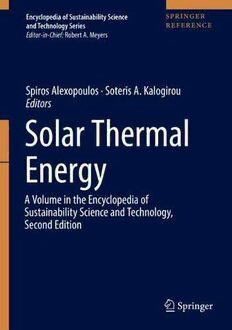
Solar Thermal Energy PDF
Preview Solar Thermal Energy
Encyclopedia of Sustainability Science and Technology Series Editor-in-Chief: Robert A. Meyers Spiros Alexopoulos · Soteris A. Kalogirou Editors Solar Thermal Energy A Volume in the Encyclopedia of Sustainability Science and Technology, Second Edition Encyclopedia of Sustainability Science and Technology Series Editor-in-Chief RobertA.Meyers The Encyclopedia of Sustainability Science and Technology series (ESST) addresses the grand challenge for science and engineering today. It provides unprecedented, peer-reviewed coverage in more than 600 separate articles comprising 20 topical volumes, incorporating many updates from the first edition as well as new articles. ESSTestablishes a foundation for the many sustainability and policy evaluations being performed in institutions worldwide. An indispensable resource for scientistsandengineers indeveloping new technologies and for applying existing technologies to sustainability, the EncyclopediaofSustainabilityScienceandTechnologyseriesispresentedat theuniversityandprofessionallevelneededforscientists,engineers,andtheir studentstosupportrealprogressinsustainabilityscienceandtechnology. Althoughtheemphasisisonscienceandtechnologyratherthanpolicy,the EncyclopediaofSustainabilityScienceandTechnologyseriesisalsoacom- prehensive and authoritative resource for policy makers who want to under- stand the scope of research and development and how these bottom-up innovationsmapontothesustainabilitychallenge. Moreinformationaboutthisseriesathttps://link.springer.com/bookseries/15436 (cid:129) Spiros Alexopoulos Soteris A. Kalogirou Editors Solar Thermal Energy A Volume in the Encyclopedia of Sustainability Science and Technology, Second Edition With360Figuresand 51Tables Editors SpirosAlexopoulos SoterisA.Kalogirou Solar-InstititutJülich(SIJ) DepartmentofMechanicalEngineering FHAachenUniversityof andMaterialScienceandEngineering AppliedSciences CyprusUniversityofTechnology Jülich,Nordrhein-Westfalen,Germany Limassol,Cyprus ISBN978-1-0716-1421-1 ISBN978-1-0716-1422-8(eBook) ISBN978-1-0716-1423-5(printandelectronicbundle) https://doi.org/10.1007/978-1-0716-1422-8 ©SpringerScience+BusinessMedia,LLC,partofSpringerNature2022 Thisworkissubjecttocopyright.AllrightsarereservedbythePublisher,whetherthewholeor part of the material is concerned, specifically the rights of translation, reprinting, reuse of illustrations,recitation,broadcasting,reproductiononmicrofilmsorinanyotherphysicalway, andtransmissionorinformationstorageandretrieval,electronicadaptation,computersoftware,or bysimilarordissimilarmethodologynowknownorhereafterdeveloped. Theuseofgeneraldescriptivenames,registerednames,trademarks,servicemarks,etc.inthis publicationdoesnotimply,evenintheabsenceofaspecificstatement,thatsuchnamesareexempt fromtherelevantprotectivelawsandregulationsandthereforefreeforgeneraluse. Thepublisher,theauthors,andtheeditorsaresafetoassumethattheadviceandinformationinthis bookarebelievedtobetrueandaccurateatthedateofpublication.Neitherthepublishernorthe authorsortheeditorsgiveawarranty,expressedorimplied,withrespecttothematerialcontained hereinorforanyerrorsoromissionsthatmayhavebeenmade.Thepublisherremainsneutralwith regardtojurisdictionalclaimsinpublishedmapsandinstitutionalaffiliations. ThisSpringerimprintispublishedbytheregisteredcompanySpringerScience+BusinessMedia, LLCpartofSpringerNature. Theregisteredcompanyaddressis:1NewYorkPlaza,NewYork,NY10004,U.S.A. Dedicated to our families for the support offered during the preparation of this revised edition Series Preface Our nearly 1000-member team recognizes that all elements of sustainability scienceandtechnologycontinuetoadvanceasdoesourunderstandingofthe needsforenergy,water,cleanair,food,mobility,andhealth,andtherelationof every single aspect of this vast and interconnected body of knowledge to climatechange.Ourencyclopediacontentisatalevelforuniversitystudents, professors,engineers,andotherpracticingprofessionals.Itisgratifyingforour teamtonotethatouronlinefirsteditionhasbeenheavilyutilizedasevidenced by over 500,000 downloads, which of course is in addition to scientists’ utilizationoftheencyclopediaandindividual“spin-off”volumesinprint. NowwearepleasedtohaveaLivingReferenceonlinewhichassuresthe sustainabilitycommunitythatweareprovidingthelatestpeer-reviewedcon- tentcoveringthescienceandtechnologyofthesustainabilityoftheEarth.We arealsopublishingthecontentasaseriesofindividualtopicalbooksforease usebythosewithaninterestinparticularsubjects,andwithexpertoversightin each field to ensure that the second edition presents the state of the science today. Our team covers the physical, chemical, and biological processes that underlie the Earth system, including pollution and remediation and climate change, and we comprehensively cover every energy and environment tech- nology as well as all types of food production, water, transportation and the sustainablebuiltenvironment. Our team of 15 board members includes two Nobel Prize winners (Kroto and Fischlin), two former directors of the NSF (Colwell and Killeen), the formerpresidentoftheRoyalSociety(LordMay),andthechiefscientistofthe Rocky Mountain Institute (Amory Lovins). And our more than 40 eminent sectioneditorsandnowbookeditorsassurequalityofourselectedauthorsand theirreviewpresentations. Theextentofourcoverageclearlysetsourprojectapartfromotherpubli- cationswhichnowexist,bothinextentanddepth.Infact,currentcompendia ofthescienceandtechnologyofseveralofthesetopicsdonotpresentlyexist and yetthe content iscrucialtoany evaluation and planning for the sustain- abilityoftheEarth.Itisimportanttonotethattheemphasisofourprojectison scienceandtechnologyandnotonpolicyandpositions.Rather,policymakers will use our presentations to evaluate sustainability options. Vital scientific issuesinclude:humanandanimalecologicalsupportsystems,energysupply and effects, the planet’s climate system, systems of agriculture, industry, forestry, fisheries andthe ocean, fresh water and human communities, waste vii viii SeriesPreface disposal, transportationandthebuilt environmentingeneral andthevarious systems on which they depend, and the balance of all of these with sustain- ability.Inthiscontext,sustainabilityisacharacteristicofaprocessorstatethat can be maintained at a certain level indefinitely even as global population increasestowardninebillionby2050.Thepopulationgrowth,andthehopefor increaseinwealth,impliessomethinglikea50%increaseinfooddemandby asearlyas2030.Atthesametime,theproportionofthepopulationthatlivesin an urban environmentwill go up from about 47% to60%. Global economic activity is expected to grow 500%, and global energy and materials use is expectedtoincreaseby300%overthisperiod.Thatmeanstherearegoingto besomerealproblemsforenergy,agriculture,andwater,anditisincreasingly clearthatconflictingdemandsamongbiofuels,foodcrops,andenvironmental protection will be difficult to reconcile. The “green revolution” was heavily dependentonfertilizerswhicharemanufacturedusingincreasinglyexpensive and diminishing reserves offossil fuels. In addition, about 70% of available freshwaterisusedforagriculture.Clearly,manynaturalresourceswilleither becomedepletedorscarcerelativetopopulation. PalmDesert,CA,USA RobertA.Meyers,Ph.D. September2021 Editor-in-Chief Volume Preface The impact of greenhouse effect on climate is taking on big dimensions. A high frequency of huge mega-fires in dry areas of California and Canada, Siberia, the tropics, Australia, and the Mediterranean area as well as floods, longerdroughtperiods,andmanyotherclimatic extremesaredirectlycorre- latedtothisglobalhuman-madeeffect.Additionally,theworldpopulationis growing nonstop, which results in a strongly increasing energy demand globally.InordertofacetheseproblemsandreducetheglobalCO emission, 2 differentapproachesareconsidered.Oneofthemwhichisconsideredinthis volumeistheexpansionoftheuseofsolarthermalsystems(concentratedand non-concentrating)forenergy,heat,andcooling. Solarthermalenergyasarenewablesourceofenergyhasbeenusedalready since ancient times; thus, there exists a broad knowledge about this energy carrier, which include environmentally sound, economically viable, and sociallyacceptabletechnologicalsolutionsforefficientenergyprovision. Theoverarchinggoalofthisvolumeistogiveanupdateaboutthevarious solar thermal technologies, concentrated and non-concentrated; the different conversion pathways for the provision of heat, electricity, and/or cooling; as well as selected superior aspects related to different applications of solar thermal energy. Following this setting, the present volume consists of the followingparts: (cid:129) PartI,Introduction.Ageneraloverviewofsolarthermalenergysystemsis givenwithinthisvolumetosetthesceneforthefollowingexplanations.An additionalhistoricalintroductioninthisfieldisprovidedaswell. (cid:129) PartII,SolarThermalConcentratedSystems.Initially,themethodologyfor theestimation ofconcentrated solar poweris presented. Then eachofthe concentratedsolarpowertechnologiesisdescribedindetail. (cid:129) PartIII,ApplicationofSolarThermalConcentratedSystems.Measurement andmonitoringmethodsforconcentratedsystemsarepresented.Animpor- tantfocusissetonporousmaterialswhicharewidelyusedinthesesystems. Further applications include solar thermal storage and different thermo- chemicalprocesses.Nowadays,animportantroleisgiventothedynamic behaviorofsolar-concentratedplants,especiallyasthesolarirradiationisa volatileenergysourcethatimposesvariationsinavailableenergy,andalso to solar simulators, which have the ability to create a temporally stable radiationwithaspectrumclosetorealsunlight. ix x VolumePreface (cid:129) PartIV,Non-concentratingSolarThermalSystemsandTheirApplication. In this part, solar thermal systems excluding concentrated ones are described together with their applications, such as solar cooling, solar detoxificationanddisinfectionofwater,solarcooking,andsolardrying. (cid:129) Thevolumecloseswiththeconsiderationofsomegeneralaspectsregard- ingthelifecycleanalysisofbothconcentratingandnon-concentratingsolar thermalsystems. It should be emphasized that while solar thermal engineering has been developed rapidly for nearly four decades, many challenging scientific and technological issues need to be solved. It is a long-term task to develop and promotethisfield,andexchangeofideasandknowledgebetweenscientistsis necessary.ThefirsteditionofthisvolumeeditedbyDr.Richterwaspublished in 2013. It is ourgreat honor to edit the second edition of this volume. This volume is suitable for scientists, professors, researchers, R&D industrial specialists, students, scholars, technicians, and managers working in the relatedfields.Itpresentsfundamentalprinciplesandcutting-edgetechnologies for sustainably harnessing this vital resource and provides a comprehensive introductiontothosewhoarenewtothesefields,aswellasnewinsightsfor advancedresearchersandindustryexperts.Wehopethisvolumeisbeneficial tothereadersandcanpromotethedevelopmentofsolarthermalengineering. Wewishtothankthenewauthorsofthesecondeditionfortheirvaluable contributions as well as their high motivation and strong engagement. We wouldalsoliketothanktheauthorsofthefirsteditionfortheirwillingnessto participateagaininthiseditionandtoupdateandrevisetheirchapters.Without theirsupport,thispublicationwouldnothavebeenpossible.Additionally,we wouldliketothankthepublisherforthepositiveandstraightforwardcollab- oration. We are especially grateful to Sunali Mull and Neha Thapa for their continuous support based on very pleasant and extremely helpful communications. Aachen,Germany SpirosAlexopoulos Nicosia,Cyprus SoterisA.Kalogirou February2022
